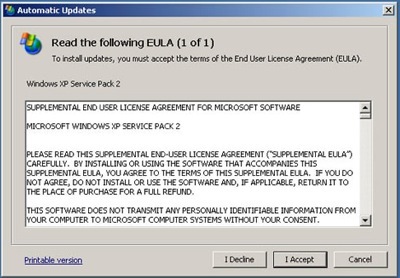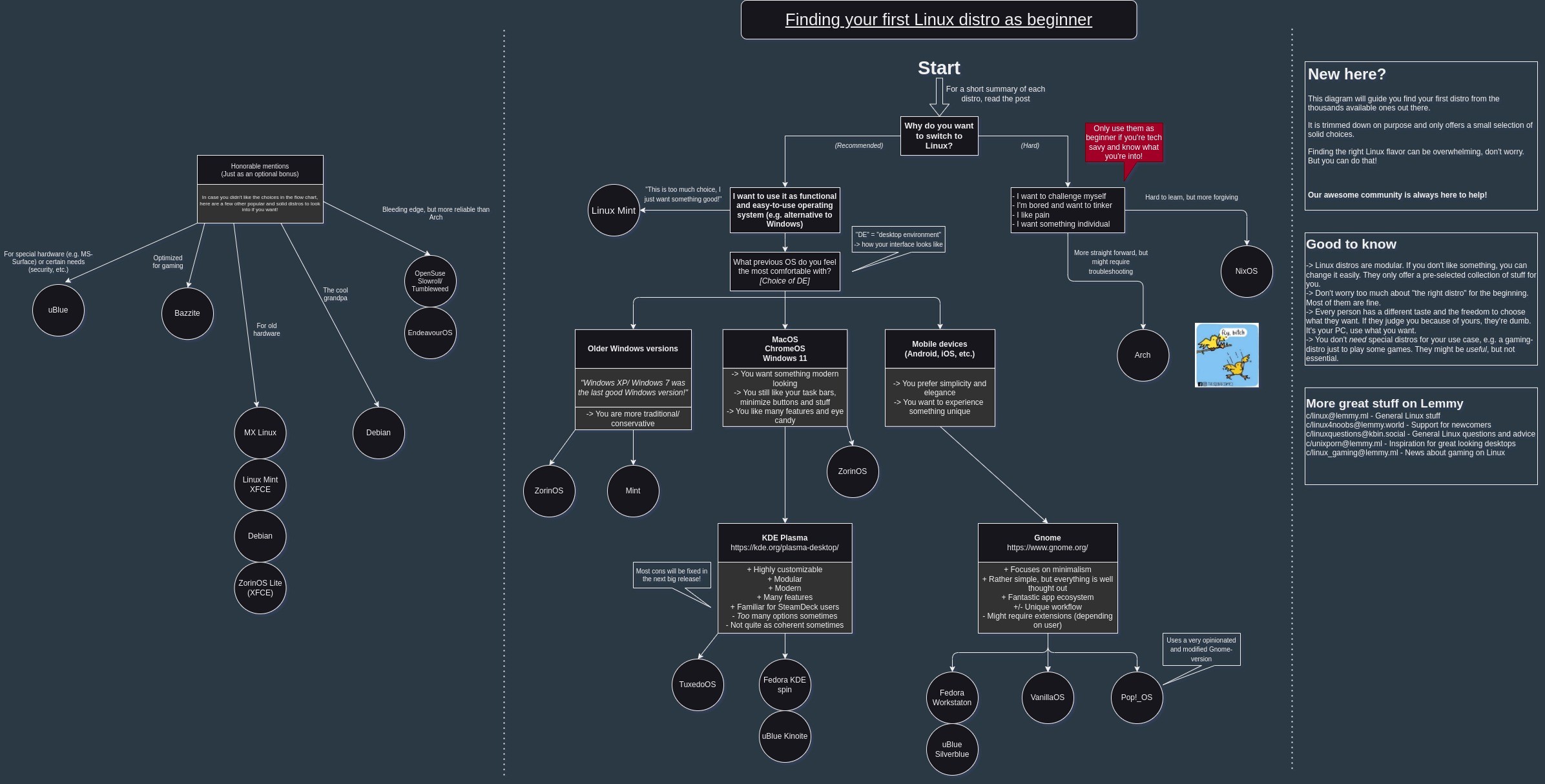Unpopular opinion: The Windows Registry, a centralized, strongly typed key:value database for application settings, is actually superior to hundreds of individual dotfiles, each one written in its own janky customized DSL, with its own idea of where it should live in the file system, etc.
Which is why I prefer NixOS (I use NixOS btw)
btw i use Nixos
The language itself has no type enforcement, the type checking is implemented within nixpkgs. This might seem like pedantry, but it really matters for things like LSPs (text editor autocomplete). I think that’s what scares some people off: it’s like OG Minecraft, you need to have the wiki/search.nixos.org open while you are doing your editing.
That being said, the type checking goes much deeper than what the windows registry does - e.g. it won’t allow you to enable conflicting services - like grub and systemd-boot - at the same time.
claps
I agreee with you on the side of the concept, but the way it is organised and the potential values seem to make no intuitive sense (if they make any)
That is true.
But, due to the nature of how it works, it can be also used to hide data that the user “should not be aware of”.
So can a dotfile, or any other kind of storage. There’s really nothing inherently bad about the registry. Its reputation as a place to hide things in is equal parts selection bias, users’ lack of technical understanding, and the marketing of “registry cleaner” apps.
But… it is a place to hide things 🤨.
I won’t argue about leftovers when uninstallig, some package managers do that as well, plus it’s not really the registry’s fault, that’s just bad or badly configured installers/uninstallers.
I mean, you don’t HAVE to do any of that stuff in Windows, it’s just helps a bit.
I’m sure there are plenty of windows horror stories. But almost every Windows computer I’ve had in the last decade, both custom and OEM, has worked pretty well out of the box. And almost every Ubuntu computer I’ve had over the last decade has had problems that weren’t trivial to fix.
I like Linux, but when people compare these problems like they’re the same just are missing the point.
Yep exactly this. The user friendliness and likeliness it just works is much higher for Windows.
If it doesn’t work for Linux I’ve found it also will generally take much longer to figure out and fix.
Sure because
Error Code 0x8007057tells you immediately how to solve the problem.Linux error messages like
error: kex_exchange_identification: client sent invalid protocol identifier "GET /robots.txt HTTP/1.1"are completely arcane tough.I support both systems. And Linux support is so much easier. Mostly in runs out of the box. If it runs I continues to do so and If you have an error you get a specific message like above.
With such a message you either:
- See right away how to solve the problem
- Search it online and get a specific solution for exactly you problem
- Or you can ask Experts for a solution for your specific problem.
With Windows: No systems runs out of the box, I always have to install additional software (7zip, sane browser, …) and also for anybody remotely privacy concerned have to adjust many settings (for which tools exist thankfully)
If an error occurs under Windows and I get a code like above:
- I can sometimes guess by my experience what the reason is and solve it.
- If not I search the error code and circumstances which lead to it online, then apply the 20 solutions presented one by one in hope one works
- Ask experts which ask me to run a bunch of diagnostic utilities because the error message does not tell you anything. (Yes by now I can also guess which utility could provide relevant information, but not because Windows told me)
- In a noticeable amount of cases the solution is: We can not determine the reason for the error, please reset everything (First a restart, then run this cleanup tool and if this doesn’t help just reinstall!)
My experience is summed up as: -If it is broken in Linux, I will have to fix it, but with knowledge the errors are diagnosable and reparable -If it is broken in Windows, it has a decent chance that it will fix itself. However once it fails to fix itself, then it’s maddening to figure out how to repair it leading to the “screw it, just reinstall”
So if neither one breaks, congratulations, they both seem pretty solid.
If a fairly common breakage occurs, Windows looks weird but it fixes itself, Linux meanwhile bleats what is an arcane error to a non-tech person, maybe refusing to boot.
If a really stubborn breakage occurs, advantage back to Linux as at least a skilled person has a chance of repairing it.
7zip built in now, and edge is decent
The true test is, would you install it for your mom. Have fun figuring out her public library and ereader shit on Linux.
I’ve installed it for my mom. She mostly just checks mail, writes some documents and browses the web. She said she didn’t notice a difference, everything worked as it should.
Sure, but then I upgraded my working out of the box Windows 8 machine to Windows 10 and it became unusable because it has a hard drive, not an SSD. Select between running an unsupported system and being able to use your computer without it stuttering every 2 seconds…
I do admit I don’t really trust the windows upgrade process. Not for any specific reason, just vibes.
I haven’t used an HDD in a long time, so idk the current state of affairs, but when win10 first came out, HDDs were fine. That’s a bummer though, and win10 is more expensive both in the cost of the OS itself and in the hardware you need to buy for it. You can run Linux on a potato. But that’s not really the kind of issue that this post is talking about, afaict.
Now, it’s unusable with a HDD. LTSC is barely usable with a HDD. Win11 on a HDD, no way. Have tried it, it boots for like an eternity.
Reserved bandwidth??
Some sort of hidden, concealed, clandestine internal QoS implementation in Windows. Reserving a portion of network bandwidth for high priority traffic sounds like a good concept, but I don’t like the fact that this is so hidden (I’ve been working with computers for many years and I’ve never heard of it until now), and that the mechanism to determine the priority of a packet is unknown.
We know windows spyware traffic have the top priority.
I love shitting on Windows as much as anyone, but that is a completely baseless, fictitious accusation. And if not, give me a credible source.
If anything, I’d keep spyware traffic as low-profile as reasonable in Microsoft’s place.
I tend to agree.
Nevertheless, some unknown implementation can have bugs and things can go wrong and there’s nothing you can do about it, short of “rebooting” or d̷o̶w̸s̸i̷n̴g̸ ̴t̶h̸e̷ ̸h̵a̵r̵d̷ ̵d̷r̶i̴v̶e̷ ̵w̶i̴t̸h̷ ̸̞̺͠h̵̺͙̎̍o̸͔͠ͅḻ̷̀̇y̵͚͍̎ ̷͉̅̅w̸͎̔a̷̧̫̒́t̶̼̉̓ę̵̾͗r̶̫͑͑ ̴̣̿͒(̷͙̎a̸̬̺͝͝n̸̞̓̓d̴̬͌̍ ̸͇͕͌͝s̷̡̯̓͝u̸̡̳̇͝b̴̳͜͠s̷͍̘̽ë̵̜q̷̝͐̄ȕ̵̞̐e̷̲̠̐́ń̴̨̙͝t̸̛̬͝l̶̮̔͠y̴͕̪̑͝ ̵̖̆ḃ̴̪̟u̶̢͓͑̌y̵̜̤͌̏i̵̦̋ň̴̨͚̀g̸͓͑ ̴͍̬̽à̶͜ ̴͇͔̓n̴̬͂͜ì̷̢̛̯c̴̤̖̈́e̶̼̫̐̊ ̵̹̏͝f̸̙̀̑r̷̪̩͆͆e̸̤̫͛͋s̷̢̙̏h̷͇͔́ ̸̭̆͝N̷̰͗͛͜V̶͇͒̚M̸̟̍͜ě̷̛̟ ̸̢̞́͝a̷͙͔͒͒n̷̻͇͝d̸̘̥͌̾ ̴̜͓͑p̷̬͑͊ŭ̸̮̏t̸̲̀t̴̡͚̽í̶͎͓̑n̴͕̘̒̈́g̴͓̰̓͝ ̵͓̎a̴̻̼͗ ̷̦̍̈́s̷̥̅̈l̴̝̂e̴̞̅͊ḛ̴̊̅k̷͚̕ ̵̛̼̬͗D̴̻̾̽e̵̙͂̊b̷̝͘ī̵̢͇ą̵̂n̴͖̑ ̶̼̚h̴̼͂͑e̷̲͆̆a̵̡̋d̸̢͔̈l̶͕̍̍e̸̛͕̙̒s̶̞͔̀͠s̸̯͖̕ ̵͍̦̈́̉ ̸̨̨̓i̸̙͖͗̌ņ̶̯̍s̸̡̖͗̇ṯ̷́̒ä̵̦́̎l̶̼̄l̵̨͊̊ ̴̳͑͗ó̵͎̅ǹ̴͈̚ ̷͖͊͝i̷̠͇̊t̷̼̞͒͘)̵͎̤̔͌
Well not spyware per se but over the years they found over and over bugs which are really just highways left open in your system ready to be exploited. But to be honest that’s not limited to windows.
It’s used for updates. I’m not sure if it works all the time.
I think that it used to be called
superfetchin the old days. https://answers.microsoft.com/en-us/windows/forum/all/superfetch-service-disable-helps-to-increase-speed/3c4d5b4b-edef-4eb7-9456-52fd304e606cIf you’re using an “unofficial” license, it’s probably normal to disable updates and afferent services.
I remember from years ago when I was modding Windows XP installations with nLite to try to purge all the unnecessary bits and install some useful stuff. Superfetch was this annoying service that supposedly ruined online gaming due to lag. :)
Prefetch and superfecth are just obnoxious services that waste disk space. You can safely disable them, there is no downside to not using prefetch or superfect on modern SSDs. On regular spinning drives, yes, they did make loading programs a bit faster.
Superfetch was keeping an index of file relationships in RAM and pre-loading files you were probably going to use next. It didn’t ping your network at all, but it could easily eat up a ton of disk resources and RAM. It was really only an issue on old 5400rpm laptop HDDs from what I remember.
Might be thinking of windows search indexing.
Yes, disable Windows search indexing as well. No point in having that on an SSD, it’s pointless, it just wastes disk space.
https://www.makeuseof.com/windows-limit-reservable-bandwidth/
It’s not as scary as it sounds.
It’s not, and in a vacuum I don’t think anyone would mind. It is the fact that it is concealed that is really shitty.
“It reserves bandwidth for high-priority tasks such as Windows Update over other tasks that compete for internet bandwidth, like streaming a movie”
As much as I’d like to keep my system up to date (and I really do), if I’m watching a movie then that is my priority. Any task I’m currently using the bandwidth on, should be considered my system’s priority. This is akin to rebooting the computer when it determines it is necessary, with the user having little control to stop it; it’s intend isn’t malicious, and it is meant to protect the user, but all it achieves is upsetting the user and make us find ways around it or turn it off completely.
20 years ago, a friend said “Windows does whatever you don’t tell it not to do”. It is as true now as it was then.
90% of configuring Windows is disabling shit.
To the reader that needs it and is too afraid to ask: https://github.com/LeDragoX/Win-Debloat-Tools
Set-ExecutionPolicy Unrestricted -Scope CurrentUser -Force; ls -Recurse .ps1 | Unblock-File; ."WinDebloatTools.ps1"
Ugh, you need to use the terminal for the simplest tasks in Windows, it’s so hard, nobody will ever use it, cope Windows users!
That’s what most people in this thread sound like. But for Linux.
Look at that powershell nonsense. We had shit for this already Microsoft.
I mean that only matters for people like us.
99.99% of the Windows user base doesn’t give the tiniest semblance of a shit about any of that. Hell I run Windows on my gaming pc still and have never had cause to do any of that.
what if you wanted to show a presentation but windows said 
I’m going to be honest with you, as often as this has been memed and for as long as I have been using Windows on my work computer, I have never once been forced to restart on the spot by an automatic update.
I’m sure those who have will be quick to reply but at this point I’m 90% confident it’s a loud minority.
I’ve seen an entire factory shut down for hours because two critical Win10 computers tried and failed to update. It’s never an issue until it becomes one.
Plus a failed update is the whole reason I nuked my C: drive and switched to Manjaro (now running Arch, put down the pitchforks).
Well, running Windows 10, a consumer user-oriented operating system, to control mission-critical machines is mistake number 1.
This wouldn’t have happened if they had used Windows Server or something actually designed for that task (like Linux!).
Neither of those options were available. It was written by a third-party for some old .NET Framework version, and the server and GUI components were written as a single application. Putting it on a server wasn’t an option either because the application’s GUI was constantly used for the management of assembly machines, and other applications were used for monitoring and administrative stuff.
If you had been there, you’d know why this was a low-priority risk. That place was bleeding from a thousand wounds. At least this had some redundancy, for all it was worth in the end…
(edit) I actually contributed to that software, even though it’s not open-source! I managed to nail down an issue where loading a project file using one locale would result in a crash, but not in others. The .NET stack trace was printed to an XHR response’s payload and I used that to locate a
float.ToString()call whereCurrentCulturewas passed as the cultureInfo instead ofInvariantCulture, so depending on the computer’s locale, it would try to parse CSV data either using a decimal dot or a decimal comma. I mailed this to the maintainer and the fix was released within the month.Well, running Windows 10, a consumer user-oriented operating system
Huh… I wonder why there’s versions of it called “Enterprise” then. You might want to talk with Microsoft about their clear mistake. I mean clearly https://www.microsoft.com/en-us/microsoft-365/windows/windows-11-enterprise is in error since you’re correct right?
I work in IT. Windows 10/11 Enterprise is still a bad choice. If it’s a mission-critical system and you must choose Windows, pony up the cash for Windows Server.
The difference between Windows Enterprise and Pro/Home editions is that there are features on it that make my job easier, but it’s still the same shitty operating system under the hood. Windows Server is much more robust and reliable in my experience. Still shit, but slightly less so. It’s designed to run on machines with 24/7 uptime. Windows Enterprise still expects you to regularly restart it for updates and upgrades. That’s alright since we can just set Susan from Finance’s computer to update at 03:00. It’s not okay if that computer controls the entire factory.
I too work in IT… Just because I have some HR users that need to run Quickbooks, I don’t buy them Windows server 2022.
Yes, because even once is too many.
In a corporate, I spent an hour and half every morning waiting for Windows to update. Then my coworker handed me Fedora DVD and I never looked back.
I’m saying it’s never happened to me. Not once. Zero times. Zero is less than one.
Normal Windows updates don’t take an hour long. Give me a break. The ones that do are the version upgrades. That’s like the equivalent of a distro upgrade.
Sure, your experience may be different.
That happened in 2013 with random laptop they gave me. I kid you not it took that long, could have been a bug somewhere in the OEM, never cared enough to find out.
But my experience is just as real as much as yours.
Normal Windows updates don’t take an hour
Correct. But who can tell the difference beforehand between a normal update and an abnormal one? The problem is Windows tends to hide those details. I’ve sat on support calls where a server needs to be rebooted for some configuration change, and Windows insists on applying updates because hey, you’re rebooting anyway, so what if it takes 1/2 hour to do this thing that should take 5 minutes…
Sure Windows gives you warning, but after a while it FORCES you to install, even if for whatever reason that new branch bricks your computer. I had a good 6 months of that where every time my computer got shut off, it would force the update and fail like 40 times before it finally let me revert and use my computer. There was no way to tell it to STOP UPDATING
I had almost the same thing for about 2 months before I gave up and switched to linux, only difference is I would get up to go to the bathroom, come back and it’s already trying to up date, that happened to me pretty regularly
Open services.msc, disable the windows update service, and set the start type to disabled. The go to C:\Windows\SoftwareDistribution and delete the entire folder.
Ive not had “must update on the spot right this very second,” but ive had countless, “we will update the second u power off or attempt a restart. If you try and restart into ur linux partition, we will somehow ensure u fail to boot right up until u got thru with our forced update.” Which also sometimes goes hand in hand with, “oops, i was supposed to update, but i shit myself instead. Youre going to need to try again at least once or twice. Dont worry, whether the update goes thru or not, itll only take a maximum of 90 minutes.”
Windows can fuck its facehole thru its ass as far as its auto updates are concerned for all i care.
Use LTSC and this and never worry about Windows deleting shit in Home or updates breaking something, do it ONLY when YOU want to update.
You right click the candy crush icon and press remove.
Whotf does the other two things?
Linux soy boys pushin lies
I don’t know about the windows stuff, haven’t used it in years. But back in the day installing Ubuntu was super easy (just boot from USB stick and install and mostly everything works). But a fresh windows install was a real pain like downloading drivers for all your hardware etc.
Nowadays it’s pretty easy in both cases I guess.
Ya I remember installing drivers for 95 etc.
Computers were a lot different to work with back then .
Learning Linux is learning how to use a computer.
Learning Windows is learning how to avoid big companies will when you want to use your computer.Learning Linux is learning how to use your computer
Learning Windows is learning how to use their computer
Lol
That’s Linus of LTT in the top
“WhY iS pAcKaGe MaNaGeMeNt So HaRd” my brother in Christ you got one broken Deb that was packaged and provided for free by someone other than the vendor, the vendor provides their own installer you could have used that wouldn’t have had the issue. You could have also used a flatpak. You were literally offered three ways to install the software on any operating system you could choose, and you gave up after the marginally simplest one failed and you were too lazy to troubleshoot it.
The donkey doesn’t even know the first thing about package management or any part of the build process, and has no right whatsoever to talk about it as if the maintainers of the stack are to blame.
/rant fuck that self-absorbed short stack sponge
Your rant is justified.
But if you compare that to a user who is used to only one way of installing a system and only one way of installing new Software. Then it can be overwhelming at first glance when you are in the middle of a problem with what seems to be the only way to install packages and not in the overview of multiple package managers.
I’m 110% with you here. Debian have make it much more difficult to break your system, so it should be stack sponge proof going forward. I still wouldn’t put it past Linus to fuck it up some other way (you know, maybe he’ll curl HTML into bash instead of a script), and he’ll still stand his ground and blame the world. And then later give one of his non-apology apologies.
I used to be a huge fan.
Same, I was a fan for a while despite them not being great about accuracy, it was entertaining tech-themed content that I knew not to trust for anything serious. Them recommending a custom windows rom that disabled any anti-virus and blocked security updates was when I completely wrote them off. And their excuse was “we showed some of the issues on screen for like 1/2 a second, that’s enough” and refused to acknowledge anyone’s concerns were valid.
Then later it got way worse when it turned out they had issues with serial harassment and stole and auctioned off prototype hardware.
Here’s probably the worst part of that situation: He got that error, because the Pop!_Shop caught the unreasonable prerequisites and said “Nope, not doing that” and threw that “failed to install Steam” message. Someone who deserves to be the CEO of a tech broadcaster would have the troubleshooting skills to, I dunno, google “popos failed to install steam” and follow instructions on how to fix it. No, what happened was he threw a temper tantrum about how Linux GUIs never work and you have to use the terminal.
The Pop!_Shop’s flawed design (in that it doesn’t update the apt cache on launch for some reason), that bugged .deb, and a whiny little fuckboy lined up just right to take the system down.
This is rage bait
I am currently dual booting and trying to get feature parity in my Linux install as a reletave newbie.
So far the largest hurdle I’ve been able to solve was getting my RAID array recognized. That sent me down a rabbit hole.
To get it working in Linux I needed to:
- switch from LMDE to Mint proper
- add a PPA repository
- install the RAID driver
- manually edit my grub config file to ignore AHCI
- run a command to apply the change
- reboot
- format the volume
To get it working in Windows I needed to:
- format the volume(Windows gave me a popup with a single button to do this on login)
You’d normally use a software raid implementation these days, and Linux has a number of those. But yeah, dual booting can expose some quirks and filesystems and disk setup in general is one of the most prominent.
This. How an advanced use case is accomplished is not a point against a system’s usability.
The point I was trying to make is that if you ever want to do something that is not covered with an out of the box install, it’s typically far harder to do in Linux than in Windows (although my ~15 years as a windows sysadmin probably bias my opinion)
Windows is turning into a telemetry nightmare because about 10 years ago Microsoft figured out that they could sell ad space and monetize user data, so I’m trying to get off the platform before my LTSC install hits EOL. But I have to admit it’s a hard path.
Now do a raid like it’s typical for Linux and get it to work on Windows.
(although my ~15 years as a windows sysadmin probably bias my opinion)
So basically: it’s not any harder in linux, but you have more than a decade of muscle memory in windows, so it’s harder for you.
That’s like saying “Japanese is a less efficient language than English, all of the words are different, and when I want to say a word, I have to learn it first, but in English I just know the words! English is so much better! (My 30 years speaking english probably bias my opinion)”
Things are certainly different, but its hard to compare which is “harder” for the advanced use cases.
There’s no shame in having long term experience with one platform and having that shape your expectation about how a solution should look.
But in your example raid controller driver was covered in an out of the box install in windows. If it wasn’t you’ll still need to do pretty much the same. Also there was a couple of weird steps in your linux list like switching DE to run a couple of CLI commands and disabling AHCI for some reason.
For advanced, power user stuff, I find Linux to be much friendlier and faster. Just being able to do everything in a Terminal instead of having to mess around with a mix of inconsistent GUI menus in the two different control panels, gpedit, regedit (which is an entire headache by itself), a mix of cmd and Powershell (and whatever Windows Terminal is) is just so much less of a headache.
Also I find things easier to script in Linux compared to Windows.
Not to mention the mess that is Windows Update, which doesn’t even upgrade third party software, and takes a long time to actually do the updates. Package management is a godsend. Windows has chocolatey and winget, but those are poor substitutes.
And I say all of this as someone who is technically proficient in both.
Are you using hardware RAID? yeah, that doesn’t go too well with Linux… works perfectly in Windows though, cuz their softraid solutions are shit.
Why have I never thought about this? Dual boot and bit by bit work on feature parity while still having an OS that’s my daily driver.
Beware of the W̷̞̬̍̌͘͜ĭ̴̬̹̟͕̒̆̈́n̸̢̧̙̈́̅̂̆̕͜ͅd̵̟̟̪͎̀̀ő̴̼̺̺́̐̂͘w̵̨͊̀s̵̡͎̭̊ ̸͔̬͔̜̊́̈́̌̈́ͅŬ̴͉͚̳̌̉͘͝p̸̼̅̆͐̃̑d̸̜͂ǎ̵̛̯̏͝ť̷̰é̸͇͝ as it can screw up/overwrite your other bootloader completely.
Kinda sucks, when you’ve got a meeting/work and you find out that forced update made your system unbootable/partially unbootable and you now get to live boot in and go fixing the EFI partition manually, in the CLI.
That happened to me once and that’s when I decided feature parity was less important than a reliable system that “just works” for getting things done on a schedule. (I removed windows completely, in case that wasn’t clear)
Anyhow, make sure you install windows to a separate drive that can’t see any others during the windows install, then will keep the bootloader separate.
I ran into similar issues before. My plan was to install Linux on a separate M.2 so Windows won’t interfere and manually boot the OS I want to manually.
The longer i spend on lemmy the more curious i become about running linux.
I’m a cool grandpa with old hardware.
Definitely mint!
If you actually will be going to, i could personally recommend EndeavourOS. Don’t fall for “Ubuntu is best for noobs”, it isn’t, and in my experience it lacks stability.
Also, if you’re not quite a mouse person, you could try tiling wms on your journey, like i3 or awesomewm. For me i3 is one of the major reasons to never return back. The ability to actually be able to do all you need with just a keyboard is huge for me, and something I was looking for even before switching to linux. Now floating wms and especially Windows itself seem so unhandy and irritating
Maybe Linux mint, I love archlinux as much as the next guy but jumping head first into a glass of water takes practice. Unless you revel in the challenge of jumping in the deep end just so you can learn how to swim like I do!
I’m just glad I chose arch instead of Gentoo. I got plenty of will power to learn something new but waiting hours or even days for a bunch of software to compile was too much for me.

I’m just glad I chose arch instead of Gentoo. I got plenty of will power to learn something new but waiting hours or even days for a bunch of software to compile was too much for me.
But the documentation is really good and I like the simplicity of OpenRC. Give Void or Alpine a go if you want to dip your toes into something similar, but without all the compiling.
I like OpenRC! I never really measured it but it feels like a much faster boot time than systemd. I’d have to get used to the syntax and writing my own scripts but if the majority of Linux distros switched to it tomorrow I’d enjoy it.
Big and small projects alike typically have poor documentation for alternative init systems and what they depend on in the aystemd ecosystem so I’ll probably stick to systemd for now. The poor documentation on alternative init systems is probably one of the biggest reasons Gentoo doesn’t move fast on getting new projects in their repos.
I’d have to get used to the syntax and writing my own scripts but if the majority of Linux distros switched to it tomorrow I’d enjoy it.
I don’t think I wrote more than one or two init scripts during my years of using Gentoo, the packages usually come with them. The newer syntax looks like you can get by with just a few variables and a dependency definition, not that different from a unit file I think.
How’s the init script management access? I had a friend try to switch to openrc on Arch (I know) and he had a terrible experience, most likely because it’s Arch and not Arco which is designed for alternative init systems. Do you have to write and maintain your own init scripts, or is that created during installation?
Do you have to write and maintain your own init scripts, or is that created during installation?
Packages should come with the necessary scripts (on Gentoo and Alpine they do), but if they don’t for some reason then writing them is pretty simple. I think the updated layout really only needs dependencies and a couple variables defined.
Void uses Runit which is even simpler, you have one directory per service and at least a script called “run” in there which gets executed by the supervisor. The is usually just one line, that’s all it takes to make a service work. It also has the supervisor take care of handling logging, similar to what Systemd does. I think it’s a very clean, modern take on classic init, except that dependency/ordering doesn’t exist - it just retries until things fall into place. Works well though.
i wonder if you can do a waterfall init where you can have an entry point that defines what services to run next. then you services can continue to pass on the next to run, or if it encounters one with a service that isn’t running, it looks at what services that one requires and traverses up to start the root unstarted service. Easy way to define dependencies without much hassle. The former case handles system services, the latter handles application services.
EndeavourOS is as simply installed as Ubuntu, even better, considering last time i tried, ubuntu installer gave me some weird errors few times. I think EndeavourOS is actually the best for noobs because of AUR and yay. AUR is supperior to all that PPA stuff. Not to mention the great ArchWiki. All Ubuntu has is forums, not so comprehensive. Mint has even less comprehensive answers on its forum, and they’re a lot often outdated. And not all answers from the ubuntu ones are relevant for mint. Opposing to them, what’s relevant for Arch is relevant for endeavourOS. Also, it comes in nice flavours, offered during the install process. Not to mention the “welcome” utility helping you make some initial tweaks.
AUR was super confusing to me as a new user when I was running Manjaro for a few months. It still donent really make sense since it seems like it throws every advantage of a package manager out the window
As far as I’ve heard, manjaro is notorious for its AUR “support” so no wonders. For me on my EndeavourOS setup its as easy as running “yay -S *package name*” to install one or just “yay” to update everything and then everything just works.
Just started on EOS this week after running Manjaro a few years back and then running Debian derivatives for a few years. I really like it, everything has been so smooth (well, other than some minor issues with upgrading to Plasma 6 yesterday I suppose, but that’s not in EOS I suppose). I was a little bit lazy about learning the ins and outs of pacman and yay, but I immediately found pacseek, which has been a pretty nice TUI package manager
The problem with RTFM is that TFM often does not cover the problem, and broader knowledge of the OS is required. You can’t expect every app to come with a manual that covers how the entire OS works, but that knowledge is often required to get work done in Linux.
People familiar with the guts of Linux or Windows will encounter these kinds of outside-the-instructions problems and know from experience what arcane setting to change or what 3rd party software needs to be installed before the procedures written in the manual will work as expected.
IMO, the Windows GUI lowers the bar to begin trial-and-error learning and makes the learning process faster.
Every Linux question I’ve ever had have been answered by the Arch Wiki
IMO, the Windows GUI lowers the bar
You can say that again. If a windows “admin” can’t find their C:\ drive or their next > next > next > finish wizard, they’re completely lost
OP never watched the LTT Linux video
Edit: for people that also haven’t watched it: Linus tried to use Pop-OS for gaming. When he tried to install Steam it uninstalled his desktop-environment leaving him with only a terminal.
it did warn him to be fair. he had to type out “yes, do as i say”, which is a HUGE red flag. even to me, a farely casual windows user.
Just watched that portion. When he scrolls down to “yes do as I say” you can literally see two lines above it stating it will remove desktop environment.
Outputs exist for a reason, folks.
And that is why Linux isn’t as widely distributed as Windows. Linux is great, if you know what you are doing. But most of the world doesn’t have the time needed to learn Linux well enough to avoid major fuck-ups like this.
Linux gives you a wall of text when all the user did (at least what they thought they did) is say install this program. The system ask “Are you sure?” And the user is like “Yes, just do it!” I can’t imagine anything on Windows doing that lol.
I like Linux and I think it’s great, but I can certainly understand why the majority of people are wary of it.
Windows would never show the user a wall of incomprehensible text with serious implications and expect them to just click yes!
Windows:

Linus was conditioned by Windows to just click “yes” on everything.
That is an EULA …
Most every piece of software has it.
Also, that EULA is 15 years old, couldn’t find a more recent one?
Because clicking yes will never catastrophically hose your environment.
Just read?
Counterpoint: Installing widely used software and following common instructions to do so should not ever put you one confirmation away from destroying your desktop environment, no matter how explicit that confirmation is.
Counterpoint: Destroying my desktop environment is exactly the thing I want to do. For real, this is one of the first things I do on the regular. One safety-net for noobs is exactly enough, any more and it will become frustrating to power users.
…and installing Steam is the route you want to use to do that?
If you want to be able to tear down your environment and rebuild it or use something else yourself that’s great. I don’t want that taken away from you.
It absolutely should not be in the chain of possible effects from trying to install a common piece of desktop software with a broad target audience.
To play devils advocate, I’d say that the bigger issue is that Linus ended up in the terminal to start with, when he had no idea what he was doing in there.
If Linux is to hit the masses, then a beginner friendly distro should have the convention to install apps be by GUI instead of TUI, and guides should be updated to reflect this. That GUI-based installer should see that the “Yes, do as I say” prompt was triggered and in a clear and concise way, inform the user that important packages will be removed if they continue and they should not.
Effectively just having a much better interface for the user is what I’m saying.
Effectively just having a much better interface for the user is what I’m saying.
It amazes me the amount of grognards that despise any interface that isn’t a command line terminal. “I can do everything on the terminal!” - True, but that’s because the UI sucks and lacks proper buttons, widgets and whatnot. That no linux distro comes with a “builtin” icon (available after an installation) or shortcut to “update all programs” or “update only security packages”, or even an easy solution to auto update everything on the background, without having to type the command, really shows how little thought is given to user experience. All solutions recquiring a terminal automatically fail in regards to bringing people to linux.
It amazes me the amount of grognards that despise any interface that isn’t a command line terminal. “I can do everything on the terminal!” - True, but that’s because the UI sucks and lacks proper buttons, widgets and whatnot.
For me, it’s not despising anything that is not the terminal but a simple preference for the terminal. Having started learning computers in a CLI and having worked professionally for over a decade mainly on the CLI, it’s comfortable and familiar. I also like having scripting and regex capabilities built into my interface - a reason that I much prefer (neo)vim to VSCode and others.
Could I do nearly everything that I do in the terminal in a modern DE? Probably. I’m just not as familiar, so, it would take longer. Like writing in cursive for someone who rarely does anything but block letters.
That no linux distro comes with a “builtin” icon (available after an installation) or shortcut to “update all programs” or “update only security packages”, or even an easy solution to auto update everything on the background, without having to type the command, really shows how little thought is given to user experience.
That’s not very accurate. Every modern desktop distro that I’ve used has this, from *buntu to SteamOS. Linux Mint probably has one of the best UI experiences for updates that I’ve seen and I frequently use it for managing kernels as it’s much simpler to do with that tool than any other that I’ve used.
All solutions recquiring a terminal automatically fail in regards to bringing people to linux.
This is one that is somewhat tricky. Linux tends to be more geared towards more technical users. Probably a lot of us chronic Linux users came to computing when it was more of a niche thing for nerds and knowing how to use a computer meant more than writing documents, editing spreadsheets, or playing games on Newgrounds. A fault that many Linux users and devs have is an antipathy or indifference towards non-technical users. I know that I’m frequently guilty of the latter. Many of us, perhaps short-sightedly, are not concerned or interested in growing the userbase of the OS, which makes efforts like SteamOS particularly great due to their enabling of non-technical users.
a beginner friendly distro should have the convention to install apps be by GUI instead of TUI, and guides should be updated to reflect this
It is a lot harder (and less helpful) in a written guide to tell someone to press a button in menu such-and-such; telling someone to open the terminal and copy paste a command is easier.
In addition (though I do not know if it applies so much to gui package managers) GUI apps also have the tendency to not have a stable interface, so a blender 2 tutorial will often not be useful for someone using blender 3, because the interface will have changed and buttons that were once in one place now are somewhere else or no longer exist. CLI programs for some reason are a lot more backwards compatible in my experience.
I think GUI apps should ideally be designed to be usable without the user knowing where something is beforehand (though that is not always possible, like in complex software handling a lot of stuff a new user may not be familiar with, when they only want to achieve a certain specific goal), making mentioning how the UI works almost superfluous in those cases.
telling someone to open the terminal and copy paste a command is easier.
No, it is most definitely not.
Any non-tech user would freeze at the mere sight of a command line. Let alone have to use it.
I’ve had people tell me I am a hacker because I open command prompt to ping something.
It was hidden in a massive wall of text. Ain’t nobody got time for that
Man was installing Steam why does it even want to remove his desktop environment to begin with.
He specifically did it in the terminal, which is aimed for power user (unfortunately most guides tell people to use the terminal at this point, but this is starting to change), and typed the text with the warning above saying essential component will be removed, with the components clearly listed, and he read it.
When he did the install on store, which is meant for regular user, the installer did stop him and tell him essential part will be removed, and refuse to go through.
Installer problem will happen, most installer on windows run as admin, and can also break stuff if they want to.
So please pardon me, but I honestly don’t see how much more user friendly this can be, maybe you have some ideas? The only option I can think of is to not give anyone the opportunity to remove desktop environment, but that is like android won’t let you remove any launcher app.
Maybe make it so it installs when you click it in the store?
The only reason he opened it in the terminal is because the store didn’t work in the first place and it didn’t give him any good explanation why.
Like I said, the installer has a bug. Softwares have bugs and installers are softwares. Installer bug can happen on Windows, Linux, and probably macOS too.
The obligation of the OS is to stop the installer when potentially unwanted behavior is detected. And the store and terminal are both doing that. The store even tells linus that this will likely be fixed later, and he can try again.
So I personally don’t see what more reason the store can provide than “this installer is trying to remove essential software, try again later”. Maybe the developer can be more specific to say that “this can brick your system”, “remove your desktop environment”, or “you will be booted into a terminal”, but I doubt an average users will know what that means either.
A big reason people see less software bugs on Windows is because more people are using it and reporting bugs. This is why many linux user are tirelessly (perhaps annoyingly, to some) preaching Linux. Because getting more user to Linux is the only way to ensure our future of stable and free softwares.
A big reason people see less software bugs on Windows is because more people are using it and reporting bugs. This is why many linux user are tirelessly (perhaps annoyingly, to some) preaching Linux.
Reminds me of bitcoin.
A particular version of the steam.deb file got pushed to the Ubuntu repository that had some bugged prerequisites. If it didn’t recognize the exact DE you were using, it would deem it incompatible and try to remove it. This wasn’t a problem for a lot of more popular distros running more popular DEs, but it caught Pop!_OS and their goofy fork of Gnome.
Prior to That Video, this issue had been found, reported and fixed. But it just so happens that bugged version was what was in the apt cache at the time the install image Linus used was made.
Further, Pop!_OS didn’t ever suggest Linus do a system update after a fresh install, nor did it update the apt cache when launching the Pop!_Shop, so that out of date apt cache was used.
Further, instead of googling an error message he was given and trying to solve the problem, the child that walks like a CEO threw a tantrum about “you have to use the terminal” looked up the command to install Linux via apt, also failed to do an update first (which you typically do; most guides about installing something tell you do an apt update && apt upgrade first) and he just plowed right through to a borked install.
Yeah lil bro is shadowboxing against a fictional, perceived “LTT”.
The problem was using some esoteric loonix distro that’s not Ubuntu or mint. Smh
It’s a problem with APT not updating it’s packages/programs/version list before installing a software.
He should do “sudo apt update”, before “sudo apt install steam”, but of course it’s apt problem for not doing it automatically. Someone who uses Linux for longer would install it from Flatpak app store or something, but it’s clearly not simple “wrong distro, bro”.
The fact there are so many distros and only a handful are “the good ones” (which changes with every user you ask) is one of the major reasons Linux is is not user friendly at all.
Making users make a very major decision before they even install an OS is definitely not a good way to retain users, especially when there’s someone saying they’re wrong no matter what they pick
Pop-OS is esoteric now?
Yes. Poop-OS
Linus is dunning-kruger crystallized and refined. He routinely talks authoritatively about subjects he knows little about. His qubit analogy is particularly wrong and annoying, and he doesn’t stop bringing it up.
Either way, more idiot filters have been installed in front of that and you’ll have to do way more work (likely learning something in the process) to fuck your system up like that.
Least condescending Linux user
Nah, it’s just Linus. I have endless time for people who want to learn. Linus doesn’t want to learn, he wants to be right.
As a linux user and developer and someone who works with linux servers all day for 20 years.
Yes linux is complicated.
Try to work with Windows servers 😰. I still have nightmares.
Linux is just as complicated as windows. Windows just has layers of abstraction that give the illusion of simplicity. The problem is the process of abstraction adds complexity and removes control.
If you need the change any of the lower levels you half to think about how it effects the abstractions and the software built on top of that.
The fact that you can connect literally any device in the world to a windows machine and it just automagically works in a few seconds is something people don’t appreciate enough. Im sure microsoft put a lot of effort into that, and constantly is.
Let me plug this web cam to my linux daily driver. Oh wait, I need to check exactly what chip its running and if that specific version is supported on my specific distro and specific version. And then I find out yes it is supported but its still missing auto exposure compensation for some reason. And of course I have to install it first and all its dependencies from that specific repo im using.
Easy.
havent used windows or mac in years. feels good.
Here is an alternative Piped link(s):
https://piped.video/oHRNrgDIJfo
Piped is a privacy-respecting open-source alternative frontend to YouTube.
I’m open-source; check me out at GitHub.
























